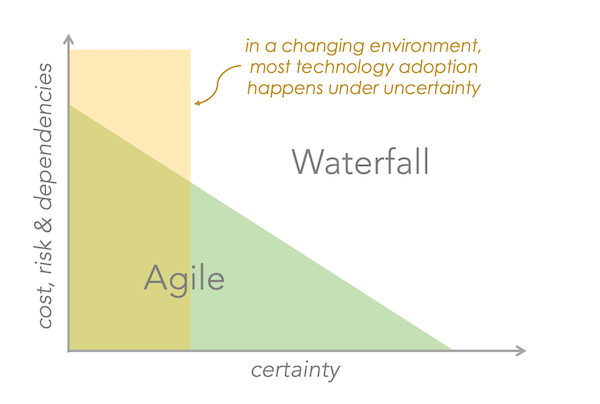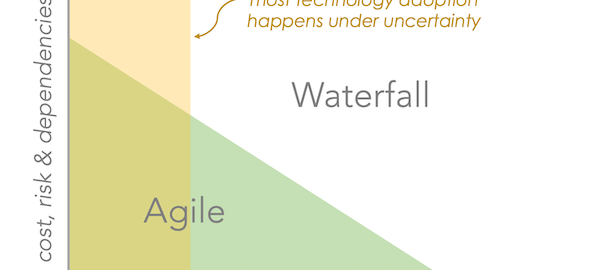Our approach to adopting new marketing technology doesn’t need to be so black and white.
Agile
A blend of two different models
It doesn’t. We can find the balance between the traditional agile and waterfall methodologies, a blended mixture of the two approaches. We shouldn’t limit ourselves to defining our methods for technology adoption, nor should our technologies be selected based on adoption. Putting labels on our processes can hinder growth. Of course, approaches will different based on use cases and business needs, but agile is about more than a shift to a new martech product, it’s a shift in organizational thinking.
Adoption costs are often a driving force behind our methodologies, noted MarTech conference chair and Hubspot vice president of platform ecosystem Scott Brinker. “In situations where you face higher costs to adopt — especially if the cost for even the initial adoption is high — or there are greater risks or dependencies around adoption, then the waterfall model is probably a better fit,” he wrote in a blog post this week. “The stakes are higher and test-and-learn is less appealing. But there is a second axis to consider: certainty, or rather, uncertainty.”

Stacey Ackerman,
Communication is crucial in agile
Teams that implement agile without clearly communicating their strategic plan — and how it will benefit users — are at risk of seeing low adoption as they attempt to scale usage upward. “The people doing the actual work are often very far removed from the customer,” said Ackerman. “Decisions are coming in from management instead of the people doing the work.”
Messaging, productivity and project management apps, all of which can solve critical business needs, are just a few examples of software that goes unused in organizations; users who are unsure of why they are using another platform are less likely to log in. Clearly communicating the value that a new tool or app is expected to deliver to users will encourage them to adopt.
Requirements vs. ‘just how we do things’
According to Ackerman, there are opportunities for even the most old-school marketing teams to try agile. “Digital marketers looking to implement agile practices can run a small pilot program where leadership feels comfortable experimenting,” she said. “Gathering a cross-functional team of five or six people with a common challenge to run a campaign can be a great learning experience. They learn a lot through that, knowing they have better collaboration and better feedback. It will also expose organizational challenges.”
Ackerman also says that digital marketers looking to shift away from the waterfall method should ask “why” specific processes or technologies exist; not understanding the reason behind certain decisions can blind us to opportunities for growth. “It’s smart for digital marketers in regulated industries to ask whether a process is in place due to legal or business requirements, or whether it’s ‘just the way we do things’,” said Ackerman.
In addition to starting with a small pilot group, Ackerman recommends that marketers consider using micro-campaigns, rather than large-scale, multichannel campaigns. “Micro-campaigns allow for customer feedback loops,” she said. “It might feel risky to leaders doing this, but it’s actually less risky because you’re validating that your marketing is resonating before you launch it all at once. It becomes a rolling, iterative strategy where marketers can apply the feedback quicker.”
The right path? ‘It depends.’
Ultimately, your organization’s needs will drive an adoption strategy that may be a combination of the two approaches. It is going to depend on the available solutions, your business challenges, organizational needs and what works best for the end users. The benefits and the risks of each method will vary depending on the product itself, the pricing and whether digital marketing teams and their organizations recognize the value.
Marketing Land – Internet Marketing News, Strategies & Tips
(41)







